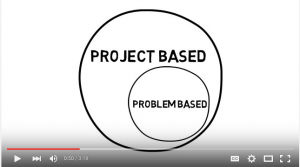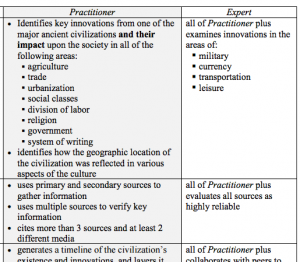At its core, problem-based learning is an approach that offers students an authentic, open-ended, complex problem to solve, which requires applying curricular content. While there are many definitions of project- and problem-based learning, let me define them for the purpose of this blogpost.
A “project” does not necessarily have to be open-ended; there is often one correct answer based on content: For example, create a salt-and-flour map of the state; create a dinosaur museum; develop a timeline to detail the cause-and-effect relationships that led to the Civil War. In each case, the content is set, available, “Googleable,” if you will, and the student is focused on the best way to present it. The only open-ended aspect is how to present the known data. A “problem,” on the other hand, must be open-ended, having no one correct content answer. Students must grapple with the content, utilizing higher-order thinking skills to formulate a response: For example, determine where your state should build the next airport; develop a habitat at your school to house a cloned dinosaur; identify a hot spot in the world that could erupt into a civil war and offer a plan to avoid it, based on your study of the Civil War addressed by your curriculum. I view problem-based learning as a subset of project-based learning.
answer. Students must grapple with the content, utilizing higher-order thinking skills to formulate a response: For example, determine where your state should build the next airport; develop a habitat at your school to house a cloned dinosaur; identify a hot spot in the world that could erupt into a civil war and offer a plan to avoid it, based on your study of the Civil War addressed by your curriculum. I view problem-based learning as a subset of project-based learning.
Given that definition, problem-based learning can be used in at least three ways to empower students and enrich the learning process:
- Use it to launch a unit of study. For example, to open a geometry unit covering the Pythagorean Theorem, present the concept that companies use geometry to determine the strength of their offerings and ask students to select an organization and determine how strong its social network is, offering mathematically defended recommendations for greater strength. (Sample unit) A rubric would drive instruction by offering steps to achieving success to guide instruction and allow students to take responsibility for their own learning.
- Use it as a transfer task. For example, at the end of units on the parts of a story (character, setting, and plot) and letter writing, ask students to write a letter to a favorite author convincing that person to write the next book about their city or town. (Sample unit) A rubric would offer assessment criteria in order to evaluate student’s content mastery.
- Use it as a curriculum document. For example, if sixth-grade social studies includes addressing ancient
 civilizations, use a problem-based task to define the curriculum standards. (Sample unit)
civilizations, use a problem-based task to define the curriculum standards. (Sample unit)
In this case, the rubric should detail the standards to be addressed, creating a “scope” for the curriculum. A series of problem-based tasks would now represent the curriculum. Teachers could use the units as is or suggest alternate problems for addressing the same content.
Using problem-based learning, you can engage students in grappling with content, create a venue for differentiation, foster executive function, and build the kinds of skills students need to succeed in the creative economy. For more information, view my video on The Case for Problem-Based Learning, join our Virtual Learning Community online course on problem-based learning, or subscribe to the IDEportal for hundreds of sample problem-based units.
